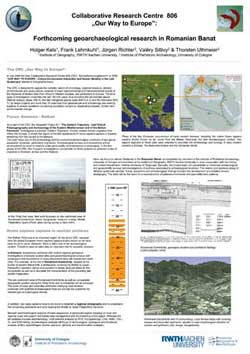LOESSFEST'09 | Aug. 31st – Sept. 3rd, 2009 |Novi Sad-Serbia
Collaborative Research Centre 806: “Our Way To Europe” – Forthcoming Geoarchaeological Research in Romanian Banat
Kels, H.1, Lehmkuhl, F.1, Richter, J.2, Sitlivy, V.1, Uthmeier, T.2
1Heinrich-Heine-Universität Düsseldorf, Universitätsstr. 1, 40225 Düsseldorf, Geographische Institut-RWTH Aachen, Wüllnerstraße 5b 52056 Aachen
2Institut für Ur- und Frühgeschichte, Universität zu Köln, Weyertal 125, 50923 Köln
In July 2009 the new Collaborative Research Centre 806 (CRC; ‘Sonderforschungsbereich’ or SFB) “OUR WAY TO EUROPE - Culture-Environment Interaction and Human Mobility in the Late Quaternary” started in Cologne/Germany. The CRC is designed to capture the complex nature of chronology, regional structure, climatic, environmental and socio-cultural contexts of major intercontinental and transcontinental events of the dispersal of Modern Man from Africa to Western Eurasia, and particularly to Europe. The time span of investigation comprises the last 190,000 years, thus including the second-last glacial (Marine Isotopic Stage, MIS 6), the last interglacial-glacial cycle (MIS 5 to 2) and the Holocene (MIS 1). 22 single projects and more than 30 scientists from geosciences and archaeology are working together to answer questions concerning population dynamics, dispersal processes, climatic and environmental change.
 As a part of the CRC, the integrated Project B1 (The „Eastern Trajectory“: Last
Glacial Palaeogeography and Archaeology of the Eastern Mediterranean and of the
Balkan Peninsula) investigates a possible “Eastern Trajectory” of early modern human
migration from Africa into Europe. It covers the region of the first appearance
of Homo sapiens sapiens in Eurasia stretching from the Levant to the Balkans.
The main focus lies on the archaeology and the environmental/ecological conditions
of last glacial population dynamics, particularly migrations. Archaeological
surveys and excavations will be accompanied by small to medium scale geoscientific
reconstructions of landscapes. In the first phase of the CRC (first 4 years),
investigations concentrate on River systems as potential routes of migration in
Southern Jordan and the Balkans.
As a part of the CRC, the integrated Project B1 (The „Eastern Trajectory“: Last
Glacial Palaeogeography and Archaeology of the Eastern Mediterranean and of the
Balkan Peninsula) investigates a possible “Eastern Trajectory” of early modern human
migration from Africa into Europe. It covers the region of the first appearance
of Homo sapiens sapiens in Eurasia stretching from the Levant to the Balkans.
The main focus lies on the archaeology and the environmental/ecological conditions
of last glacial population dynamics, particularly migrations. Archaeological
surveys and excavations will be accompanied by small to medium scale geoscientific
reconstructions of landscapes. In the first phase of the CRC (first 4 years),
investigations concentrate on River systems as potential routes of migration in
Southern Jordan and the Balkans.
Here, we focus on planed fieldworks in the Romanian Banat, accomplished
by members of the Institute of Prehistoric Archaeology, University of Cologne,
members of the Institute of Geography, RWTH Aachen University and the History
and Letters Department, Valahia University of Târgoviste. Basically, the
project team will concentrate on combined archaeological and geoscientific surveys
and investigations of archives associated to archaeological locations. The relative
and absolute dating of different sediments (aeolian, fluvial, lacustrine) and archaeological
findings includes the development of a detailed chronostratigraphy.
In addition to the fieldwork, mass calculations concerning the different documented loess units followed. The results show that in Garzweiler on a length about 1,600 meters nearly 50% of the walls is build up by Upper Würmian loess, nearly 25% were assigned to each Middle Würmian and Pre-Eemian. Only small percentages belong to sediments of Lower Würmian and Holocene age.
The latter will be the basis for a reconstruction of palaeoenvironments and past settlement patterns. The Balkan Peninsula is an important region for the entire CRC, because here the oldest European Homo sapiens sapiens fossils known so far have been found in caves. However, there is still a lack in the archaeological context. Therefore open-air sites play an important role for scientific research. In Romania, excavations combined with local to regional geological investigations of already located sites and geoarchaeological surveys with subsequent test excavations of newly discovered sites will complement each other. For example, at the site of Romănesti- DumbrăviŃa, situated at the border of western Banatian hills, a stratigraphy covering the Middle to Upper Palaeolithic transition will be re-excavated to obtain absolute dates for the Aurignacian as well as to elucidate the characteristics of the preceding late Middle Palaeolithic. The site catchment area of Romănesti-Dumbrăviţa as well as comparable topographic position along the Timis River and its tributaries will be surveyed.
The cover of loess and loess-like sediments overlying local terraces combined with stratified archaeological finds will provides the possibility for detailed geo-archaeological studies. In addition, key loess sections have to be found to establish a regional stratigraphy and to understand the concerning sediments and soils bearing the Middle to Upper Palaeolithic transition. Beneath sedimentological analysis of loess sequences, a geomorphological mapping on local and regional scale will support GIS-bases data management and 3Dmodelling of the region. Whereas the lab analysis includes sedimentology, multi element analysis by RFA, micropedology, CNS, AMS-, OSL-, TL- and ESR-dating, archaeological analysis will focus on technological, typological and functional analysis of lithic assemblages (chaîne opértoire, attribute and transformation analysis).
For more information about the CRC see http://www.qsga.de/research_ourwaytoeurope.html



